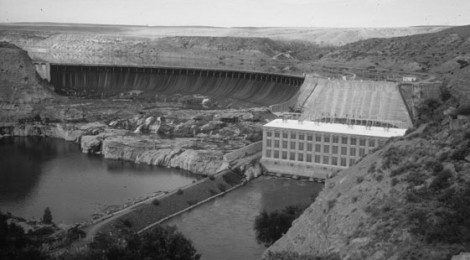
Great Falls, Montana Fall Tour, Oct. 8-11 2015
Montana’s IA, Hydropower Plus
Text by Brian Shovers and John A. McConnell, photographs by Saul Tannenbaum; from SIA Newsletter Volume 45, No. 1, Spring 2006
For the third time in the last three decades, Montana’s Klepetko SIA Chapter sponsored an annual fall tour for the national organization. Fifty members from around the country gathered in Great Falls, Oct. 8-11. We could not have asked for better weather—clear skies, warm temperatures, and peak autumn color.
Day One, a Thursday, featured an “early bird” tour to Ashgrove Cement, Marks-Miller (wood posts and poles), and the Archie Bray Foundation (former Western Clay). The crew at Ashgrove Cement provided an overview of the wet process of making Portland cement and a history of the company, organized in Sunderland, Mo. in 1882 and currently the operator of eight cement plants nationwide. Ashgrove built the 450-ft.-long rotary kiln at Montana City in 1963 to produce cement needed to construct the Yellowtail Dam on the Bighorn River. The bulk process mixes silica, shale, limestone, gypsum, and iron into a wet slurry that is fed into the kiln, which is fired with 155 tons of coal, 75 tons of coke, and 950 tons of clinker per day to a temperature of 2,700°F. Many improvements have been applied to the basic process to reduce energy consumption and air pollution impact.
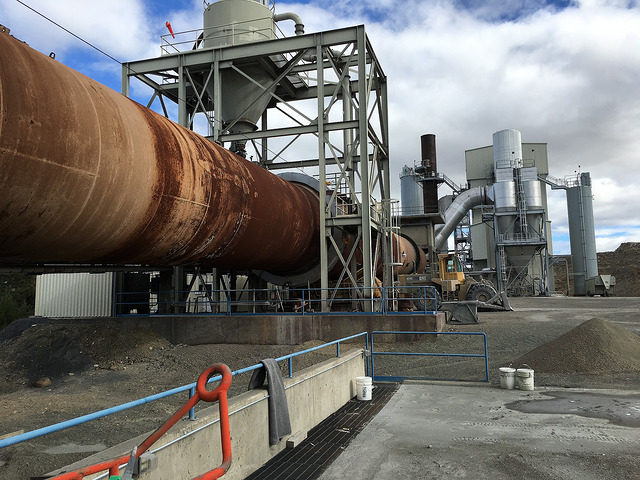
Material handling equipment at Ashgrove Cement.
At Marks-Miller in Clancy, just south of Montana City, Gary Marks, the owner over the last 39 years, began the tour by demonstrating a computerized Komatsu machine that has been modified to pick up lodgepole pine logs and snip them to appropriate lengths for fence rails and posts. The machine employs an appendage (developed in Sweden) consisting of a mechanical wrist-action grabber and a chainsaw. Marks-Miller has two units so equipped; each can process about 500 logs per 10-hour shift. Marks-Miller buys logs measuring up to 10-in. diameter, including beetle-killed timber. The mountain pine beetle carries a blue-staining fungus into the wood below the bark, and it was quite noticeable once our guide pointed it out. This fungus kills the tree by cutting off the flow of water and nutrients. Interestingly, the dead trees may last 10 to 15 years before they become so deteriorated as to not be worth harvesting. The entire process of debarking and shaping the poles into posts and fence poles takes place in a building filled with automated machinery. The pressure-treating process using chromated copper arsenate takes place in a 52-ft.-long vessel. Marks-Miller’s market for finished rails and posts is almost entirely within Montana.
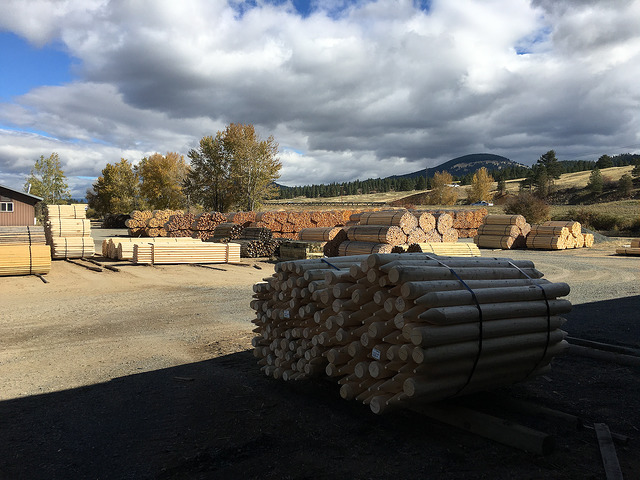
Finished fence posts at Marks-Miller in Montana City.
Our next stop and lunch was at the Archie Bray Foundation. Fred Quivik [SIA], one of the tour organizers, led our group through the historic ruins of the Western Clay Manufacturing Co., established in the 1880s. Charles Bray, an English immigrant, was Western Clay’s first general manager; he eventually became sole proprietor and passed ownership to his son Archie Bray, Sr. Decades ago Fred documented the historic structures of the world-class ceramics works, which has gradually transformed itself from a large industrial tile and pipe manufactory into an artists’ studio. Inside the kilns, the walls are coated with the remains of years of glazing from drainage tile production. It has the appearance of a thick sugar-like coating, hanging off the interior surfaces in large drips or runs like icing on an enormous Bundt cake. Lindsey Carroll, the education director, led our group on a tour of the ceramics studios while describing the origins of this unique Helena institution, which provides ceramics classes and residencies to artists from across the world.
The group returned to the tour headquarters, the O’Haire Motor Inn, to prepare for the evening reception at the Lewis & Clark Interpretive Center, located on the south bank of the Missouri River and operated by the U.S. Forest Service to commemorate the Lewis & Clark expedition. The O’Haire constitutes a “blast from the past,” transporting guests back to the 1960s when tiki lounges prevailed nationwide. The O’Haire’s Sip-N-Dip Lounge offers a view from the bar into a pool where mermaids frolic (actually women wearing shiny fabric tails). The mermaids take a deep breath and do a few back flips or loop-de-loops in front of the windows and wave to the admiring audiences.
Throughout our explorations, we were reminded of the Lewis & Clark expedition that crisscrossed the area in 1805- 06, looking for the source of the Missouri and a path to the Pacific Ocean, among other things. All four days of our touring encountered numerous monuments, exhibits, and memorials to the early explorers. At the reception, Ellen Sievert, the Cascade County Preservation Officer, invited the Preservation Players to act out the early industrial history of Great Falls. (It should be noted that Ellen helped organize the Great Falls tours and the wonderful dinner at the Ryan Dam on Saturday evening.) The re-enactors took on the personas of characters from the city’s industrial past including Paris Gibson, an acquaintance of financier James J. Hill and the man who platted the city; John D. Ryan, President of the Anaconda Copper Mining Co. and Chairman of the Board of the Montana Power Co., builder of the dams located on the Missouri below Great Falls; George Shanley, a prominent local architect; and a female smelter worker enlisted by the copper company during WWII.
Day Two began with ADF Group, Inc., a Montreal-based company established in 1956 to manufacture ornamental gates and fences. Today, ADF has plants in Terrebonne, Que.; Miami, Fla.; and Great Falls. The fabrication plant in Great Falls largely produces structural steel for petroleum operators in the Alberta tar sands. The facility comprises a 100,000-sq.-ft. fabrication shop and a 50,000-sq.-ft. coating shop, plus ample space for storage of structural steel. At the fabrication shop, we saw plasma cutting, welding, forming, punching, and drilling. The coating shop has state-of-theart environmental controls for capturing fumes and dust. Dan Rooney, the general manager, led the tour, providing a step-by-step introduction to how modules are constructed: teams of three assemble 25- to 50-ton packages of steel members for finishing.
Hydroelectric power, a central theme of this year’s tour, was on full display at Rainbow Dam, built at Rainbow Falls by Montana Power Co. in 1910. As originally designed, the 29-ft.-high dam generated 36 MW employing eight twin turbines twinturbines. Our group toured the historic powerhouse, where the generators remain in place; they were mothballed in 2015 when a new powerhouse with a single turbine producing 63 MW came on-line. The $230 million project allows Northwestern Energy, a utility headquartered in Butte, to remotely control power output. The single-turbine design also prevents the death of thousands of fish that used to be diced up in the old turbines. Northwestern operates five dams along the Missouri below Great Falls, built to supply power to Anaconda Copper. Our guide described the need to keep open water behind the dam in the extreme cold of Montana winters. Ice can place tremendous pressure on the dam, enough to literally push it downstream, so ice pack removal with cranes and digging irons is a nonstop job in the winter months.
Lunch was at Giant Springs State Park where we were also given a tour of the Montana State Fish Hatchery. Biologists described how they raise rainbow trout, which are released into rivers and lakes across Montana. Interestingly, the water coming out of the Giant Springs is supersaturated with nitrogen from two centuries or more underground. This would give the fish the equivalent of the bends, so the spring water is run through degassing towers prior to being introduced into the hatchery. We also explored the ruins of a chimney built by the Montana Smelting Co. in 1887. The silver-lead smelter was state-of-the-art when it opened but it had a short life, closing in 1901, a victim of new technologies and ore shortages.
Then it was off to Malmstrom Air Force Base, just east of Great Falls. After an extensive security check, the group entered the air base. The facility was established during WWII and became headquarters of the U.S. Air Force Strategic Air Command and an ICBM Missile Base in the 1960s. Today, Malmstrom is headquarters for the management of over 150 Minuteman 3 missiles, hidden in underground silos scattered around Montana. There are 15 control centers, each managing 10 missiles. The 60-ft. missiles are set in 90-ft.-deep underground reinforced-concrete silos. Each control center is manned by two missileers working on 24-hour shifts, which sometimes extend much longer due to winter weather and icy roads. We were allowed to enter a silo which functions as a training simulator for maintenance and repair technicians. The officers who guided us pointed out their 1980s computer system (employing floppy discs no less!), guaranteeing security through obsolescence. Our guides were willing to speak candidly about duties that are monotonous but always tinged with stress since the missileers never know if the frequent drills are real or just another rehearsal. This may have been the most sobering SIA tour ever.
Next up was Avmax, established in 1976 as Western Avionics, an international provider of avionic repairs and services for regional aircraft and private executive jet operators. Andrew Ladd showed us around a hangar at the Great Falls Airport. The hangar was built during WWII to accommodate a lend-lease program dedicated to shipping airplanes to the Russians. AvMax’s Great Falls operation employs 100 workers reconditioning jet airplanes that are sold to clients in South America, Russia, Chad, and Canada. The first step is to strip the craft of engines, pumps, fuel system components, instruments, and radio communication and navigation equipment. These are sent to outside vendors to be refurbished and overhauled.
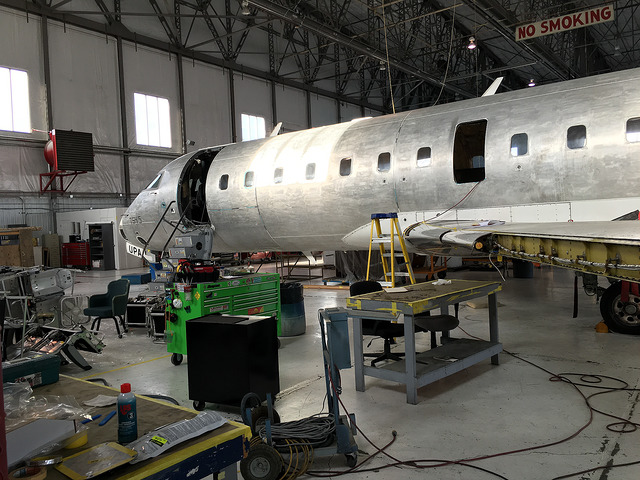
An aircraft under repair at Avmax.
Day Three dawned sunny and clear, a perfect day to visit the Big Stone Hutterite Colony, one of 38 such colonies in Montana. The Hutterites are a German Anabaptist sect that left the Ukraine in 1874 over military conscription, eventually making their way to Canada and the Dakota Territory. Expansion of the original colonies has more recently precipitated a migration west into Montana. Andrew Wirtz, the elected leader of the colony, greeted our group in a barn where 200 dairy cows are milked twice daily. The colony also raises pigs and 20,000 chickens and grows winter wheat, barley, and peas on 1,400 acres, so this is an industrial-size operation. Water is drawn from a 575-ft.-deep well. Thirty families (144 people) live in the colony’s residences, which are unadorned, following a precept from the 16th century: “Christians shall not apply their industry on outward ornamentation to please the world.” Two teenage girls served as our guides. Children attend the colony’s school through the 8th grade but when they reach 14½ years of age, they are considered adults. One of the rites of passage is being allowed to eat with the adults. Before that, the children eat in a common dining room after the adult meal. Women eat separately from the men. The Hutterites embrace certain forms of modern technology, perhaps a key to their economic success, but they strive to live in a completely utilitarian world.
The bus next made its way to the historic town of Fort Benton for lunch catered by the historic Grand Union Hotel. John Jacob Astor’s American Fur Co. established Fort Benton in 1846. A 10-year archeological dig and reconstruction project is nearing completion at the original Fort Benton site. This has helped with an accurate recreation of the fort’s log walls and adobe buildings. There is also a beautiful exhibit documenting the trade between the Blackfeet Tribe and the fur men. The Fort Benton community has also brought together an amazing collection of farm machinery in the Montana Agricultural Center, which is adjacent to the Homestead Village, a collection of buildings that represent daily life on the prairie during the “homestead boom” (1908- 1920), when Montana’s population practically doubled. Fort Benton has capitalized on its history unlike any other community in Montana, perhaps with the exception of Butte.
The day concluded at the Ryan Dam in the late autumn sun. Built by Montana Power in 1915 under the leadership of John D. Ryan, the 1,336-ft.-long and 61-ft.-high runof- the-river dam employs six turbines to generate 60 MW. Following the tour the group gathered in the dam’s 1930s clubhouse for dinner. A hearty thank you was given to Fred Quivik, Brian Shovers, and Julie Blair, who did extraordinary work to organize this year’s Fall Tour.
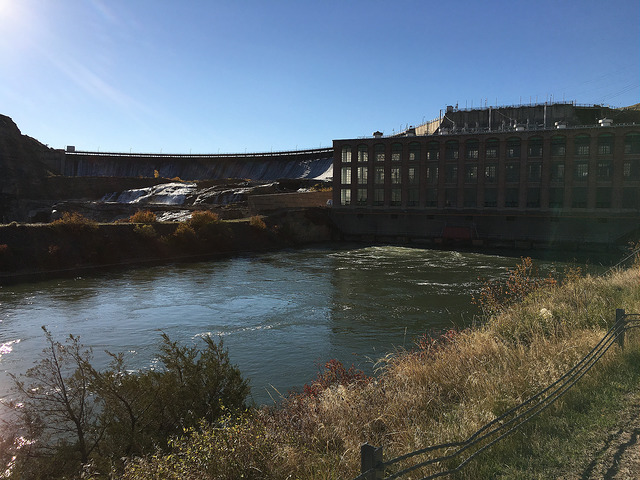
Ryan Dam in golden hour light.
On Sunday, a group of about twenty remained in Great Falls for a walking tour of the downtown. We were told Great Falls was a planned city, unusual for this part of the country. There were two building booms, the first in the 1880s and the second in the 1910s, that significantly shaped the city. The tour was hampered somewhat by winds gusting to 50 mph, so from time to time we lost the thread of our guide’s narration (and a hat or two!). But it was a fabulous bright autumn day.

